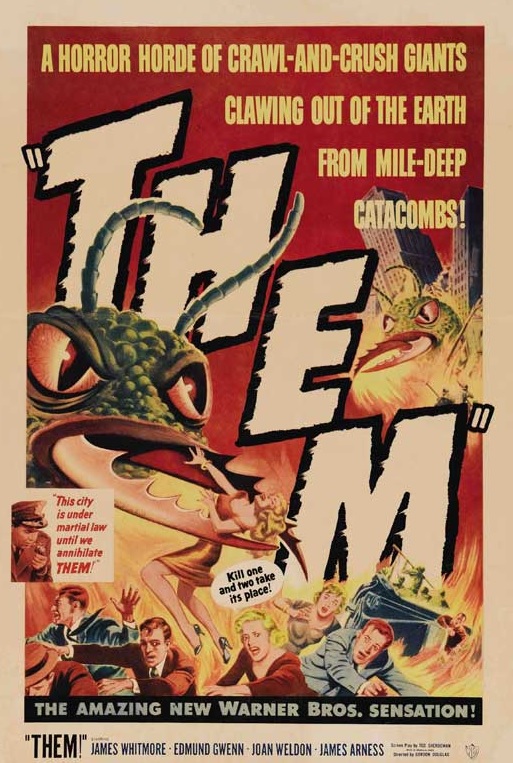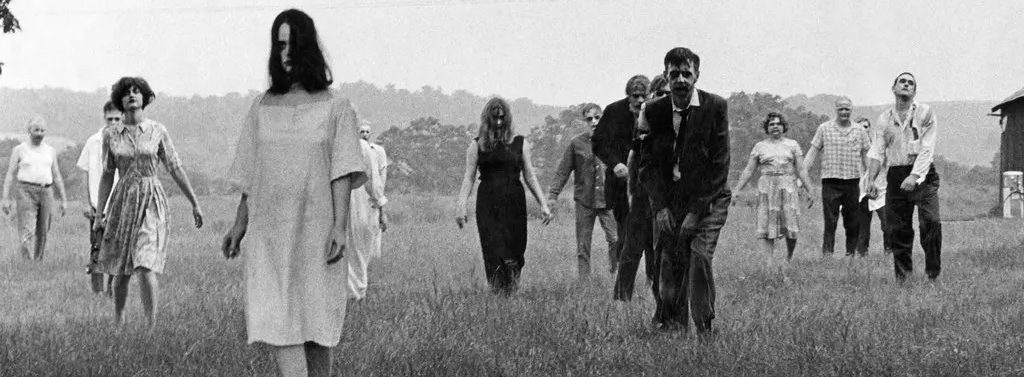In the reading for today, Peter Biskind highlights the vast array of horror/Science Fiction movies that poured out of studios in the 1950s. Some of these were alien invasion movies with weak ties to horror film history, but others, suggesting links to Frankenstein, centered on monsters brought into being by scientific experiments. As we’ve discussed, monsters carry a range of potential meanings in their otherness. What is at least one way that Biskind offers us to think about monsters, specifically in the 1950s? Below are posters from two monster movies from the decade. What kinds of threats and what sort of appropriate responses to the monster do one or both posters suggest?



Biskind suggests that monsters in 1950s sci-fi horror movies were politically charged between being leftist, centrist, or rightist ideas, depending on who was making the film. Monsters were a vehicle for showing how the self and society should react to chaos, paranoia, or crisis. A right-wing film, for example, would validate the self’s private, subjective vision. It would show a conflict between the self and society, like in “Invasion of The Body Snatchers.” Who should we trust when there’s a monster? In a left-wing film, the scientists save the day. In a right-wing film, the doctors are corrupt and the police are untrustworthy. Vigilantism is the path forward. Monsters are created as a way to criticize their creator, become a cautionary tale about theories of change, and initiate trust or distrust in current systems of power. In the “Them!” poster, the threat is the other. It is Us versus Them. They are feared because they could take Us over, given that they reproduce quickly. By placing a man and a woman in the foreground, the heterosexual balance of the world would be disturbed. We are scared because they might change things. The military is shown as the solution. In contrast, “Tarantula!” seems to be slightly different. The giant tarantula is clearly the Other, and it seems to be threatening heteronormativity. The balance of nature has been disturbed. Will scientists be able to solve the problem? Probably not, as the individuals in the foreground might be the only ones who can figure it out. They’re brightly lit and powerful. The scientists in the top-corner don’t have an idea what’s going on. The self triumphs, making it maybe a more right-wing leaning film.
In “The Other Americans”, Biskind argues that centrist sci-fi filmmakers portrayed a struggle between culture and nature in which nature is the Other; it is the threat to American civilization, to our way of being. Culture is portrayed as order that has risen from and and separated itself from nature (i.e., that which is primitive, barbarous, and uncertain) and which must defend itself. The monsters in these films are metaphors for that which threatens the order of American culture, perhaps most notably communism. They are the invaders (or perhaps threats from within), but do not arise from the order of culture itself. In other words, they do not represent technology or order gone too far.
Both posters exemplify the portrayal of nature as the invader to modern America. In both, we can see white, middle-class Americans (“Us”) under attack from the unfamiliar (“Them). These people represent the order of everyday life, the culture in which we feel should feel safe and comfortable. In the poster for “Them”, we can see an officer (a symbol of law and order) declaring the city to be under martial law until the threat is annihilated. In this portrayal, military might is seen as a force of good, a protector of the American people rather than a potential authoritarian threat. This is a clear nationalist depiction of America which acknowledges and respects the authority of the State.
The monsters depicted in horror/sci-fi, especially those from the mid 20th century, are oftentimes a metaphor for racism, xenophobia, or some other kind of othering. The monsters on these posters are no exception, both taking inspiration from nature with their buggyness, they fit in well with Biskind’s discussion around “the jungle” which is often fetishized, exoticized, and made notorious by western ideals. There is something almost orientalist about the use of nature and “primitiveness” for allegories about otherness that is rooted in the exotic, mysterious, dangerous, and sexualized nature of horror movie monsters, something that is certainly present in both posters. The first poster feels significantly more blatent in its xenophobia, with the monster’s literally being called “THEM”, the image of (white) people running away from the destruction, a (conventionally attractive blonde) woman being attacked by a monster, the military officer enstating martial law, and the fear of the “them” multiplying. The symbolism seems pretty clear: the americans have been invaded by beings (people, perhaps?) from somewhere unexplored and unfamiliar (a non american country, or potentially even just a space that isn’t prodominately white) who are going to keep multiplying until they are all “annihilated”, and need to be “annihilated” because they are depicted as nothing other than horribly violent.
According to Biskind monsters in these films symbolize otherness. Given the social context of communism in that period – McCarthyism and the Red Scare – one way that Biskind invites us to think about these monsters is through the lens of ongoing societal anxieties and fears perpetuated by the government. The monster in these movies tend to reflect the collective fears and concerns of the era, particularly regarding the unknown, science, and the potential consequences of technological advancements. Monsters were symbolic manifestations of these fears and the perceived social threats associated with progress and unpredictable affairs happening in the world, especially, outside of the U.S. On page 151, he states “like communists, the aliens hide behind false fronts” and Americans destroy what they do not know. In accordance with what Biskind argues, monsters were a tool used by both the left and the right leaning agendas of politics in the era.
The associated posters often suggest a need for unity, resilience, and the triumph of human ingenuity or courage over the threats of mutants and obvious forign (non-human) beings. As seen in the second poster of the man protecting the woman, or of the military forces depicted in the first poster, they typically showcase the struggle of humanity against these monstrous forces. Furthermore, the scientists in the corner of the second poster highlights the importance of banding together and using science or collective effort to overcome the challenges posed by these monsters.